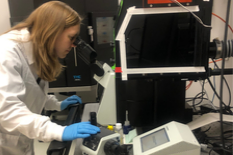Stroka Named 2019 Young Innovator of Cellular & Molecular Bioengineering
Fischell Department of Bioengineering (BIOE) assistant professor and alumna Kimberly Stroka (Ph.D. ’11) was named a 2019 Young Innovator by Cellular and Molecular Bioengineering, a journal of the Biomedical Engineering Society. Stroka was recognized for her efforts to shed new light on the factors that lead breast tumors to metastasize to the brain. Her most recent work is featured in the October 2019 special issue of Cellular and Molecular Bioengineering. Brain metastasis occurs in approximately 20 percent of all cancer cases and remains a devastating prognosis due to limited treatment options. Recent studies have shown that tumor cells are capable of metastasizing to the brain via the body’s circulatory and lymphatic systems. But, metastasis that occurs through the circulatory system requires tumor cells to traverse the blood-brain barrier – the highly selective, semi-permeable barrier made up of endothelial cells that line the blood vessels in the brain. This selective permeability of the brain endothelial cells is controlled by what are known as tight junction proteins. Tight junctions serve as fusion points between cells, and are made up of numerous proteins that join together to form a barrier to fluid. Put simply, the blood-brain barrier wouldn’t function to protect the brain from pathogens and diseases without tight junction proteins. Disruption of these junctions is linked with increased permeability of the blood-brain barrier to cells and molecules and is implicated in several diseases, including cancer metastasis. Earlier this year, Stroka and members of her Cell and Microenvironment Engineering Lab unveiled their Junction Analyzer Program (JAnaP) – a novel, Python-based program capable of providing quantitative metrics that describe the integrity of cell junction proteins in response to different biochemical and physical cues. Such a program could prove invaluable as, to date, there are no models or techniques that can be used to efficiently quantify junctional proteins as they are assembled at the cell edge. Tumor cell-derived biochemical cues and physical interaction with brain endothelial cells can alter brain endothelial cell-cell junctions in such a way that directs the mode of transendothelial migration. Moreover, tumor cells also secrete substances that can alter endothelial cells, further enhancing tumor cell transmigration at cell-cell junctions. Stroka and others in the field have demonstrated that tumor cells can even displace endothelial cells in such a way that further promotes tumor cell migration through the brain endothelium. In addition to cell-secreted factors, the extracellular matrix that surrounds the blood-brain barrier plays a critical role in cell migration; yet, little is known about which specific aspects of the brain microenvironment play a role in cancer progression. Knowing this, Stroka and her team investigated a number of factors, including what role crosslinking of hyaluronic acid – a major building block of the brain extracellular matrix – plays in disease progression to the brain. Using JAnaP, Stroka and her group set out to quantitatively analyze human brain microvascular endothelial cell (HBMEC) morphology and cell-cell junction presentation. The group quantified the time that tumor cells take to incorporate into HBMEC monolayers, as well as the percent of tumor cells that incorporate into these monolayers. Overall, their analyses showed that a combination of biochemical and physical factors promote tumor cell migration through the brain endothelium, and that extracellular matrix mechanics may play their biggest role in cancer metastasis only after tumor cells have exited the vasculature. The full Cellular and Molecular Bioengineering article is titled “Tumor Cell Mechanosensing during Incorporation into the Brain Microvascular Endothelium.” BIOE alumna Marina Pranda (Ph.D. ‘19) served as first author of the paper. BIOE graduate students Kelsey Gray and Ariana Joy DeCastro, and undergraduate student Jae Jung contributed to the paper, along with University of Maryland Department of Biology alum Greg Dawson (B.S. ‘19). In recognition of her achievement, Stroka will take part in a special platform session at this week’s 2019 Biomedical Engineering Society Annual meeting, held in Philadelphia. JAnaP is available for download on GitHub.
Related Articles: October 17, 2019 Prev Next |


